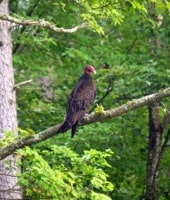Share this article
Low Altitude Soaring Gives Vultures a Competitive Edge
Low-flying vultures may be gaining a competitive edge when it comes to sniffing out the best hunk of carrion.
Researchers tracking the flying habits of turkey vultures (Cathartes aura) and black vultures (Coragyps atratus) observed the birds outside of Williamsburg, Va. using a kind of low-soaring rocking motion called contorted soaring, using weak updrafts coming off trees to soar low over the ground.
“They were doing it a large percentage of the time,” said Julie Mallon, referring to turkey vultures. Mallon — lead author of a recent study published in The Auk — conducted this research during her master’s studies at the University of West Virginia.
Some populations of turkey vultures are migratory and the birds have a huge overall range spanning from Canada down the Falkland Islands off the coast of Argentina. Mallon said that they likely adapted this behavior so they can pick up the smells that lead them to carrion.
This is evident because of the way turkey vulture behavior contrasts with black vultures, who rely on their vision and social cues from other black vultures when looking for carrion. There is competitive overlap between the two kinds of birds, but black vultures don’t use contorted soaring nearly as much as turkey vultures, as their kind of hunting is better suited to higher altitudes. The low-flying turkey vultures can use updrafts in cool and tropical climates alike.
“It’s a really a nice contrast to be able to see these two birds,” Mallon said.
While neither species is at risk in the U.S., Mallon said that one of her fellow grad students found levels of lead poisoning in vultures.
Vulture species elsewhere in the world also face a number of problems due to hunting and habitat destruction.
“Learning about these species while they’re still common is really important in case something like what’s happening in India or Africa befalls these species,” Mallon said.
Mallon conducted her research with the funding of Hawk Mountain Sanctuary, under supervisor Todd Katzner. The research wildlife biologist with the U.S. Geological Survey has been tracking the habits of vultures and other raptors across the eastern U.S. through his Appalachian Eagles camera trap project for some time.
Check out a turkey vulture in flight. The bird displays contorted soaring from around 0.51-1:10
Header Image: Vultures use small-scale turbulence to stay aloft at forest edges, a behavior that researchers have dubbed “contorted soaring.” Image Credit: M. DiGiorgio









